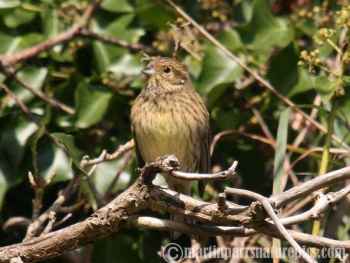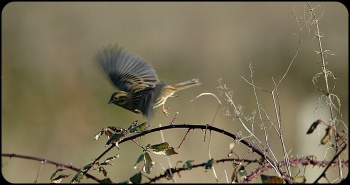- Emberiza cirlus
Identification
15-16.5cm (6-6½ in)
Male Cirl Buntings have diagnostic black and yellow faces.
The females show hints of this same black and yellow pattern including obvious broad dark lines behind and below the eye.
Similar Species
If you are in doubt about whether you have a Cirl Bunting or a Yellowhammer, check the rump colour - grey brown on a Cirl Bunting, almost red on a Yellowhammer. Also, Cirl Buntings have a small grey shoulder patch and richer chestnut on the upperparts.
Distribution
Common in the south-west of the Western Palearctic, breeds from Iberia north to south west of England, most of France and south-west Germany, east to southern Romania and north-east Turkey. In the Mediterranean, also found in the Balearic islands, Corsica, Sardinia, Sicily and Crete. In North Africa, it is found from Morocco to northwest Tunesia. It is resident throughout its range, with no migratory populations.
Now only found in the extreme south west of England (southern Devon), mostly between Plymouth and Exeter. It is also found as a naturalized species in New Zealand.
Extralimital records are rare, with only a handful of records north to Scotland, the Netherlands, Denmark, Poland and the Ukraine, and south to the Canary Islands and Egypt.
Taxonomy
Subspecies
This is a monotypic species[1].
Subspecies nigrostriata is now considered a synonym of the nominate, and therefore, the species is now monotypic.
Habitat
The preferred habitat is warm, dry scrubland and low-intensity agriculture with small fields and numerous hedges with scattered large trees for song perches; also uses large gardens close to farmland.
Behaviour
Flocks with other seed-eaters, especially Yellowhammers.
Action
Hops. A rather bounding flight.
Diet
Their diet consists mostly of seeds from herbs and grass for most of the year, with insects added during the breeding season.
Breeding
The nest is placed in a hedge or bush, and the eggs are incubated for 14 days. There can be 2 or 3 broods.
Vocalisation
Call "zit"
References
- Clements, J. F., T. S. Schulenberg, M. J. Iliff, T. A. Fredericks, J. A. Gerbracht, D. Lepage, S. M. Billerman, B. L. Sullivan, and C. L. Wood. 2022. The eBird/Clements checklist of Birds of the World: v2022. Downloaded from https://www.birds.cornell.edu/clementschecklist/download/
- Gill, F, D Donsker, and P Rasmussen (Eds). 2023. IOC World Bird List (v 13.2). Doi 10.14344/IOC.ML.13.2. http://www.worldbirdnames.org/
- ARKive
- Collins Pocket Guide to British Birds 1966
- Handbook of the Birds of the World Alive (retrieved December 2016)
Recommended Citation
- BirdForum Opus contributors. (2025) Cirl Bunting. In: BirdForum, the forum for wild birds and birding. Retrieved 17 May 2025 from https://www.birdforum.net/opus/Cirl_Bunting
External Links
GSearch checked for 2020 platform.1







